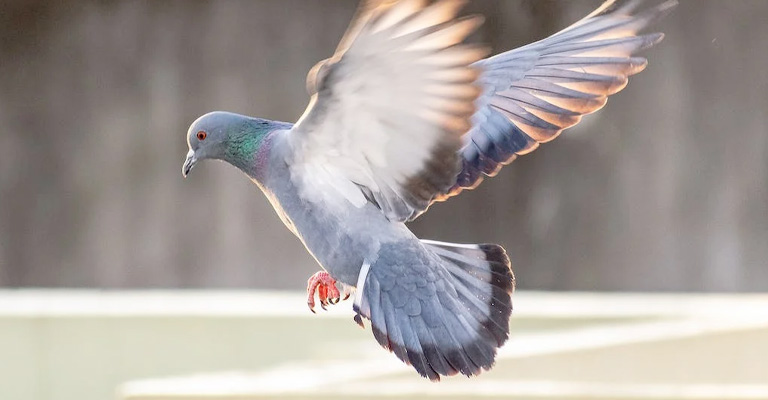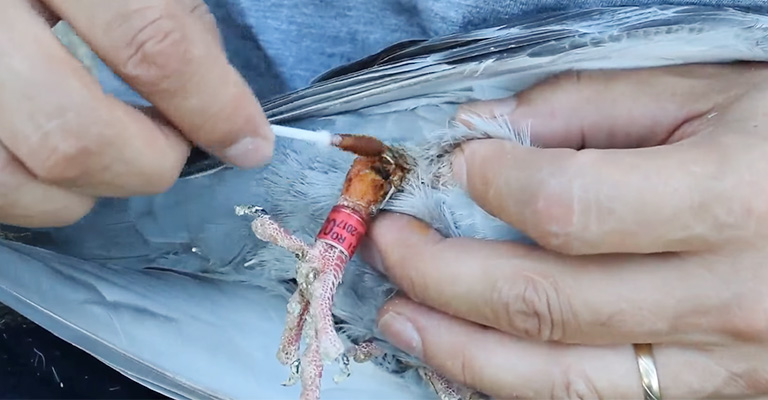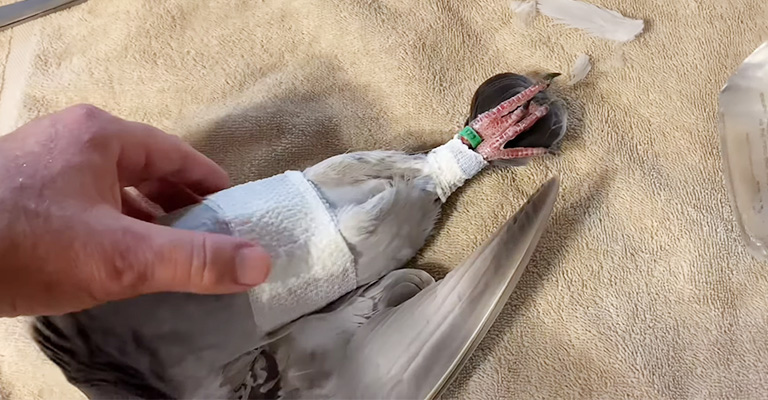The avian world never ceases to amaze with its adaptability and resilience. The idea of a pigeon, a creature synonymous with urban landscapes, attempting to defy its limitations and soar with a broken leg is a testament to the indomitable spirit of these birds.
It is a question that stirs our curiosity about the limits of avian adaptability. Can a pigeon truly fly with a broken leg, or is it grounded by such a hindrance? In this exploration, we delve into the remarkable world of pigeons and their unique abilities.
We aim to understand the challenges they face when dealing with a broken leg and the adaptations they employ in their quest for flight.
This inquiry provides insight into the astounding ways nature equips its inhabitants to overcome adversity, be it in the sky or on the ground.

Can A Pigeon Fly With A Broken Leg?
A pigeon with a broken leg faces a significant challenge when it comes to flying. While pigeons are remarkably agile and resilient birds, a broken leg can severely hinder their ability to take flight.
Flight in birds is a coordinated effort between their wings, body, and legs, and a leg injury disrupts this delicate balance. When a pigeon’s leg is broken, it struggles to generate the necessary lift and thrust needed for takeoff and sustained flight.
However, the extent to which a pigeon can fly with a broken leg may depend on the severity of the injury. If the injury is relatively minor, the pigeon may still be able to take short, low flights.
Nevertheless, sustained or long-distance flights become nearly impossible, and the injured bird is likely to stay close to its roosting or feeding area. In such cases, the pigeon may rely more on walking and hopping to get around.
Proper medical attention and rehabilitation are essential to ensure the pigeon’s recovery and a return to full flight capability, though not all pigeons with broken legs will regain their former abilities.
What Can You Do For A Pigeon With A Broken Leg?

Helping a pigeon with a broken leg involves providing care and creating a suitable environment for healing. Here are some tips on what you can do:
Isolate and Protect
If you encounter a pigeon with a broken leg, carefully capture it and place it in a safe and quiet environment, away from potential threats or stressors. A cardboard box with ventilation holes or a small animal carrier works well.
Contact a Wildlife Rehabilitator
Reach out to a local wildlife rehabilitator or veterinarian with experience in avian care. They can assess the injury and provide professional guidance and treatment.
It’s essential not to attempt setting the broken bone yourself, as improper handling can cause more harm.
Provide Water and Food
Place a shallow dish of water and pigeon-friendly food (seeds, grains, and peas) near the pigeon. Ensure a water dish that is not too deep to prevent drowning. Offer the food in small quantities and ensure it’s suitable for pigeons.
Keep it Warm
Maintain a comfortable temperature for the injured pigeon, as birds can easily become stressed and unwell if they get too cold. A heating pad set on low or a heat lamp can provide the necessary warmth without overheating.
Minimize Handling
Limit direct contact with the pigeon, as the stress of handling can exacerbate its condition. Frequent handling can also prevent it from resting and healing.
Regular Monitoring
Check on the pigeon periodically to ensure it is stable and the environment is clean. Make sure it has access to food and water. Document any changes in its condition and relay this information to the rehabilitator or vet.
Prevent Further Injuries
Keep the pigeon in a protected space to avoid any risk of predators or accidents. Ensure the enclosure is secure and well-ventilated, and avoid any hazards like sharp objects that might further harm the bird.
Remember that professional guidance and care are vital when dealing with an injured pigeon, as the proper treatment and rehabilitation are crucial for its recovery.
Wildlife rehabilitators and veterinarians can provide the best course of action for the pigeon’s specific needs.
How Long Does It Take For A Pigeon’s Broken Leg To Heal?

The healing time for a pigeon’s broken leg can vary significantly based on the severity of the injury, the type of fracture, the bird’s overall health, and the quality of care it receives.
Here are some hypothetical scenarios representing different recovery durations:
Minor fracture (2-4 Weeks)
A minor fracture, such as a hairline crack, might take around 2 to 4 weeks to heal with proper rest and care. The pigeon may require limited movement and a splint or bandage to stabilize the leg during this period.
Simple fracture (4-6 Weeks)
A simple fracture that requires immobilization and restricted movement could take about 4 to 6 weeks to heal. During this time, the pigeon should be kept in a quiet environment to prevent stress and facilitate healing.
Compound Fracture (6-8 Weeks)
A compound fracture, where the bone pierces the skin, usually takes longer to heal. With appropriate medical attention, including possible surgery, the recovery period might extend to 6 to 8 weeks. Regular monitoring and care are essential to prevent infections.
Multiple Fractures (8-10 Weeks)
If the pigeon has multiple fractures in the same leg, the healing time could be extended to 8 to 10 weeks. This situation often requires intensive medical intervention, including surgery and a more extended period of restricted movement and rest.
Fracture with dislocation (10-12 Weeks)
A fracture accompanied by joint dislocation demands careful realignment and stabilization. The recovery time may extend to 10 to 12 weeks, with consistent medical care and physical therapy to ensure proper healing and joint mobility.
Severe fracture (12-16 Weeks)
Severe fractures, especially those involving major bones like the femur or multiple fractures in different parts of the leg, require extensive medical treatment and a prolonged recovery period.
Healing might take 12 to 16 weeks, possibly longer, with constant monitoring and rehabilitation efforts.
Complex Fracture Requiring Surgery (16+ Weeks)
In cases of complex fractures that necessitate surgical intervention, the healing process can be protracted, lasting 16 weeks or more. Surgery, followed by meticulous post-operative care, rehabilitation exercises, and physiotherapy, is crucial for the pigeon’s successful recovery.
It’s important to note that these timeframes are hypothetical and can vary widely based on individual circumstances.
Professional evaluation and ongoing care by a qualified veterinarian or wildlife rehabilitator are essential to determine the most accurate prognosis and facilitate the pigeon’s optimal recovery.
Can Pigeons Survive With A Broken Leg?
Pigeons, like many birds, can indeed survive with a broken leg, but the extent to which they can thrive depends on the severity of the injury and their capacity to adapt.
Birds, including pigeons, are remarkably resilient and can compensate for injuries by redistributing their weight to the uninjured leg. However, a pigeon with a broken leg will face several challenges.
They may experience difficulty perching, walking, or taking flight. Basic activities such as foraging for food or escaping predators may become more challenging.
Pigeons may adapt by hopping, using their wings for balance, or finding shelter in low, accessible areas. While they can survive with a broken leg, their overall quality of life may be compromised, and their chances of survival in the wild may decrease.
In cases where a broken leg has a potential for recovery, timely and appropriate medical care, often provided by wildlife rehabilitators or veterinarians, can greatly improve the pigeon’s chances of healing and resuming a more normal life.
FAQs
Can a pigeon fly with a broken leg?
Pigeons can technically make short, low flights with broken legs, but their ability to fly is significantly impaired. The broken leg disrupts their balance and coordination, making it challenging to generate the necessary lift and thrust for sustained flight.
Do pigeons adapt to flying with a broken leg?
Pigeons are known for their adaptability, and some may attempt to compensate for a broken leg by redistributing their weight onto the uninjured leg. They may use their wings for balance during flight.
Can pigeons with broken legs heal and fly again?
With proper medical attention and rehabilitation, pigeons with broken legs may recover and regain their ability to fly. However, the success of this process depends on the severity of the injury and the quality of care provided.
Why would a pigeon attempt to fly with a broken leg?
Pigeons are instinctively driven to fly for survival, so even with an injury, they may try to take flight in response to threats or when seeking food. This behavior can be a matter of instinct despite the physical limitations.
How can I help a pigeon with a broken leg?
If you encounter a pigeon with a broken leg, it’s best to contact a local wildlife rehabilitator or veterinarian experienced in avian care. They can provide the necessary medical treatment and rehabilitation to improve the pigeon’s chances of healing and regaining its ability to fly.
Conclusion
The question of whether a pigeon can fly with a broken leg leads us into the captivating world of bird adaptability.
While it is theoretically possible for pigeons to make short, low flights with broken legs, their ability to take flight is significantly hindered. This limitation underscores the intricate connection between a bird’s legs, wings, and overall flight mechanics.
While pigeons may still display remarkable adaptability and resilience, their ability to navigate the skies is compromised. This insight emphasizes the fine balance of nature and the remarkable ways in which birds continue to persevere, even in the face of physical challenges.
The pigeon’s spirit of determination and adaptation serves as a reminder of the wonders of the avian world and the ever-inspiring nature of life’s resilience.